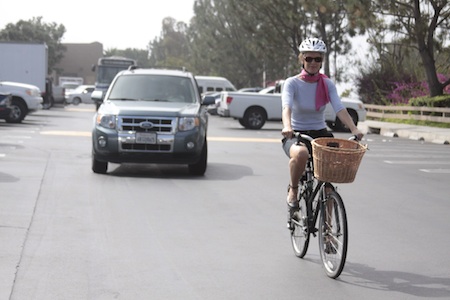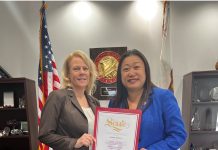Pedestrians, bicyclists and cars will soon share Laguna Beach’s first complete street following a City Council decision Tuesday, March 17, to allow separate lanes for each on Monterey Drive, one of the town’s few one-way streets.

The issue came up after residents complained that designating the shoulder as a bike lane was creating a hazard for pedestrians in a neighborhood that lacks sidewalks.
“It’s an incredible opportunity to have our first complete street,” said Joan Marcus-Colvin, widow of the cyclist John Colvin, who died after being struck by a motorist near Emerald Bay last June.
Tuesday proved a good night for pedestrian safety on another front, as well when police introduced a plan to distribute reflective bracelets as part of a safety awareness campaign.
At the urging of cyclists, Monterey Drive and other nearby North Laguna streets were designated as an alternate bike route to Coast Highway three years ago using signage. All but Monterey, which had a wide shoulder, were marked with sharrows.
It wasn’t until Monterey’s shoulder received sharrows and official designation as a separate bike lane in January that the city began to receive complaints from residents that the “bikes were conflicting with pedestrians,” Public Works Director Steve May informed the Council.
Legally, cyclists are required to ride within a designated bike lane, except to avoid obstructions, “which would include pedestrians,” the staff report says. But anecdotal evidence shows that riders don’t always heed the protocol.
Indeed, Margaret Baldwin, who lives at the corner of Hawthorne and Monterey, said she was nearly hit by cyclists twice, once while gardening at the edge of the shoulder and once while walking her dogs. Baldwin said that without sidewalks the pedestrians walk in the shoulder and it’s too dangerous to have cyclists share the space with families, children and pets.
“Right now it is unsafe for everyone,” agreed Julie Beckham, noting that bikes in packs go faster than cars and that bikers fail to halt at the stop signs.
To solve the problem, May suggested adding signs cautioning cyclists to yield to pedestrians. One alternative would be removing the bike lane designation and adding sharrows to the vehicle lane. Another could be to reconfigure the street with three travel lanes: a 13-foot vehicle lane, a 4.5-foot bike lane next to it and a 4.5-foot pedestrian lane next to the curb.
A few residents endorsed the first alternative, since they didn’t believe bikers would respect their lane designation. “That’s the safest,” said Alan Grant, who lives at the intersection of Monterey and High Drive.
But complete streets advocate Chris Prelitz rolled out a variation on May’s three-lane alternative. He urged reducing the parking lane by a foot and reducing the vehicle travel lane to 10 feet, to allow room for an all-important two- to three-foot buffer lane between the bike and car lanes. Questioned on the safety of such a narrow route for cars, he cited the Urban Street Design Guide, put out by the National Association of City Transportation Officials, which recommends 10-foot car lanes as the standard, since narrower lanes promote safer driving. “It’s hardly any expense at all. It’s just paint, but it gives us what we could truly have as our first complete street,” said Prelitz, a reference to a state mandate that calls for cities to make streets accessible to cyclists and pedestrians as well as vehicles.
“A two-foot buffer could potentially have saved my husband,” said Colvin.
Mayor Pro Tem Steve Dicterow, who lives in the neighborhood, endorsed Prelitz’s proposal, and liked the idea of a narrower car lane to slow down traffic. “No matter what we do, risk is inherent. Everybody still has to use some common sense and be careful,” he said, a nod to concerns raised by some residents that cyclists would still encroach on the pedestrian lane. In addition to the lane reconfiguration, given the volume of kids, people and pets on the walkway, he suggested signs encouraging cyclists to “watch for pedestrians.”
The Council voted 4-1 to approve the complete streets option, with Council member Toni Iseman dissenting. “Drawing these two lines side by side makes it less safe for pedestrians,” she said, preferring the first alternative with sharrows for cyclists in the car lane and leaving the shoulder for pedestrians only. “This is about safety,” she said, and pedestrians need the most protection.
Implementing a real complete street “would be a magnificent addition to our biking infrastructure,” said bike enthusiast Billy Fried, adding that it would “dovetail beautifully” with a bike rodeo the Laguna Beach Police Department will hold on Sunday that will teach kids safe biking practices. “This would be the first street that parents would be happy to see their kids ride on,” he said.
Earlier, police Capt. Darin Lenyi told the Council about a plan to distribute reflective bracelets to pedestrians and cyclists.
The bracelet idea ties in with a campaign by police to sharpen awareness of those stepping off curbs to cross a street. Between 2012 and 2014, 67 pedestrians were hit by vehicles, including three deaths, police statistics show. During the same period there were also 30 bike versus pedestrian incidents, almost all resulting in injury, with one fatality, he said.
City Manager John Pietig said he had challenged Lenyi and his team to come up with creative ways to promote safety in crosswalks. They did their research, looked at what other cities were doing and found this program in Glendale, he said. The city will spend about $4,000 to buy 5,000 bracelets and distribute them to various businesses, restaurants and hotels. “Hopefully people will use these wristbands,” he said. “It’s a start.”




